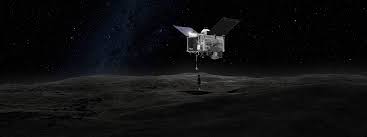2020 is a big year for asteroid sample missions as there are 2 missions objectives that are on this year.
- The NASA mission OSIRIS-REx beings sampling manuevers from 101955 Bennu in July.
- The JAXA Hayabusa2 returns from 162173 Ryugu to Earth in December.
What is an Asteroid Sample Return mission?
An asteroid sample-return mission is a spacecraft mission with the goal of collecting and returning samples from an asteroid to Earth for analysis. The amount of material that Sample-return missions may bring back merely atoms and molecules or a deposit of complex compounds such as loose material (“soil”) and rocks. This can depend on the size of the probe, the asteroid chosen, and tools to collect and store the material.
What do scientists hope to learn with these missions?
Hayabusa2 and OSIRIS-REx have the goal of returning samples to help scientists learn more about the formation of the solar system. But there are other purposes for asteroid sample missions such as composition analysis.
2020 Missions
Hayabusa 2
Launched on December 4rd 2014 at Tanegashima Space Center, Hayabusa 2 is a JAXA mission to rendezvoused and study near-Earth asteroid 162173 Ryugu. Arriving at the asteroid 162173, the probe will perform multiple science experiments using its payloads for remote sensing, sampling, and four small rovers. The goal is to investigate the asteroids surface to inform the environmental and geological context of the samples collected.
The surface samples were collected on February 21st, 2019 by having the spacecraft sampler attach to the surface of the asteroid and collect samples that were dislodged by a 5 gram tantalum bullet fired at 300 meters per second into the surface.
The sub-surface sample collection required an impactor to excavate a crater to eventually obtain material deeper from the sub-surface, which involved a complex maneuver of firing a copper bullet to make a hole in the surface of the asteroid. After said copper bullet made a hole in the surface, subsurface material was collected.
As Asteroid 162173 Ryugu, formerly named 1999 JU3, is a primitive carbonaceous near-Earth asteroid, it is expected to preserve the most pristine materials in the Solar System, a mixture of minerals, ice, and organic compounds that interact with each other. This means that the returned samples are expected to provide additional knowledge on the origin and evolution of the inner planets and, in particular, the origin of water and organic compounds on Earth, all relevant to the origin of life on Earth. The spacecraft is expected to return to Earth in December 2020, so there will be some exciting results in 2021 and beyond!
OSIRIS-REx
Launched by NASA in September of 2017, OSIRIS-REx, which stands for Origins, Spectral Interpretation, Resource Identification, Security, Regolith Explorer, has the goal of asteroid study and sample-return of at least 2.1 ounces, or 60 grams of material from 101955 Bennu. 101955 Bennu is a carbonaceous near-Earth asteroid., which will allow scientists to learn more about the formation and evolution of the Solar System, its initial stages of planet formation, and the source of organic compounds that led to the formation of life on Earth
Per NASA, :”In July 2020, the sampling maneuver is scheduled to begin, [with] OSIRIS-REx not land[ing] on Bennu to gather the sample, but it will get very close. After descending toward the surface, a process that will take several hours, the spacecraft’s robotic arm, the TAGSAM instrument, will actually make contact with the asteroid. TAGSAM will release a burst of nitrogen gas to kick up regolith particles (loose dust and rocks) from the surface. The sampler head at the end of the robotic arm will collect the regolith.”
The mission will end in 2023 by returning the gathered material to Earth, before the satellite ends its life by orbiting the sun. But without the successful maneuvering in July 2020 to capture the material, the mission won’t provide any material for scientists to study.

Leave a comment